Unit 6 At one with nature starting out and 课件(共43张PPT。内镶嵌4视频)-2025-2026学年外研版(2019)必修第一册
文档属性
| 名称 | Unit 6 At one with nature starting out and 课件(共43张PPT。内镶嵌4视频)-2025-2026学年外研版(2019)必修第一册 | 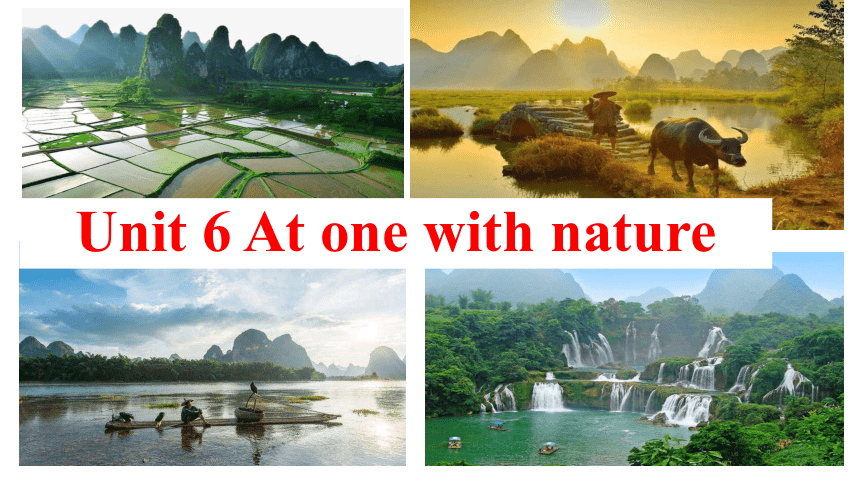 | |
| 格式 | pptx | ||
| 文件大小 | 274.2MB | ||
| 资源类型 | 教案 | ||
| 版本资源 | 外研版(2019) | ||
| 科目 | 英语 | ||
| 更新时间 | 2025-06-21 00:17:17 | ||
图片预览

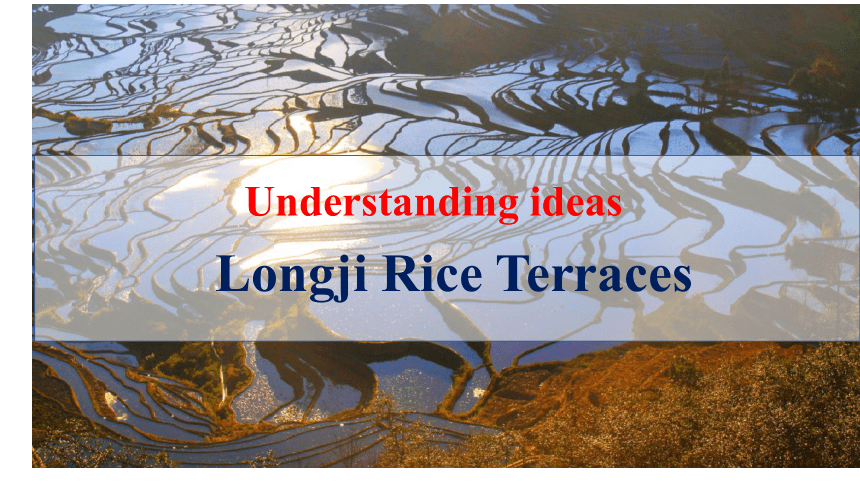

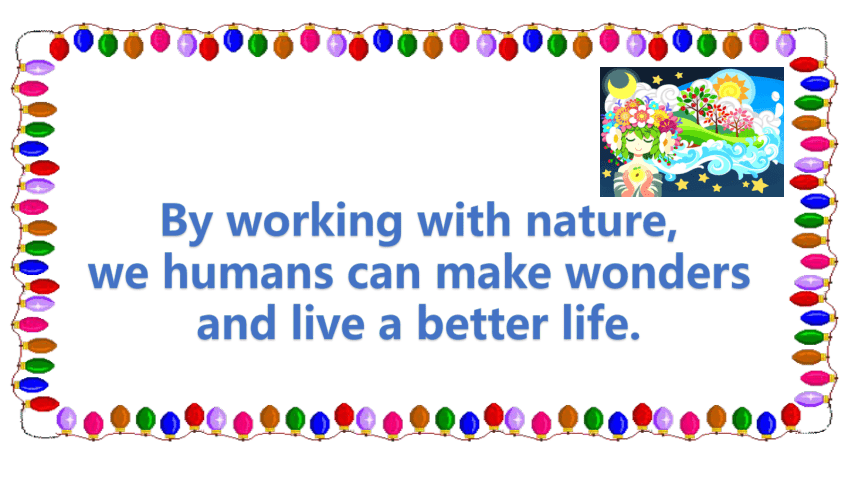




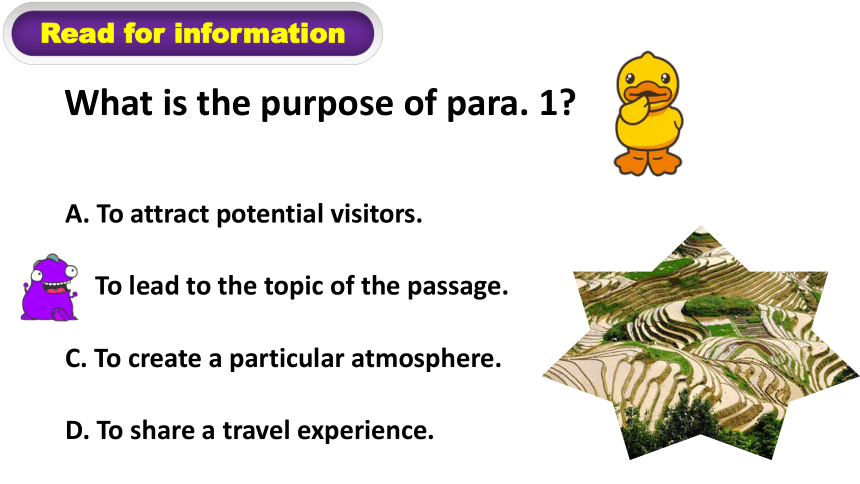
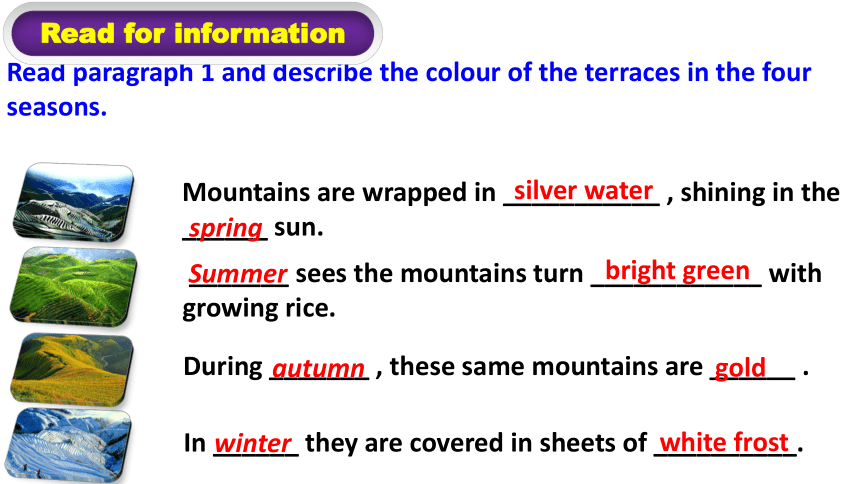
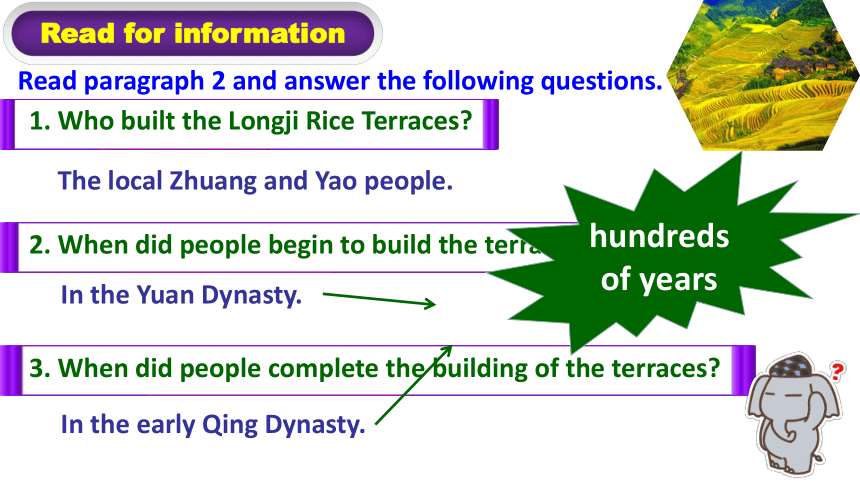
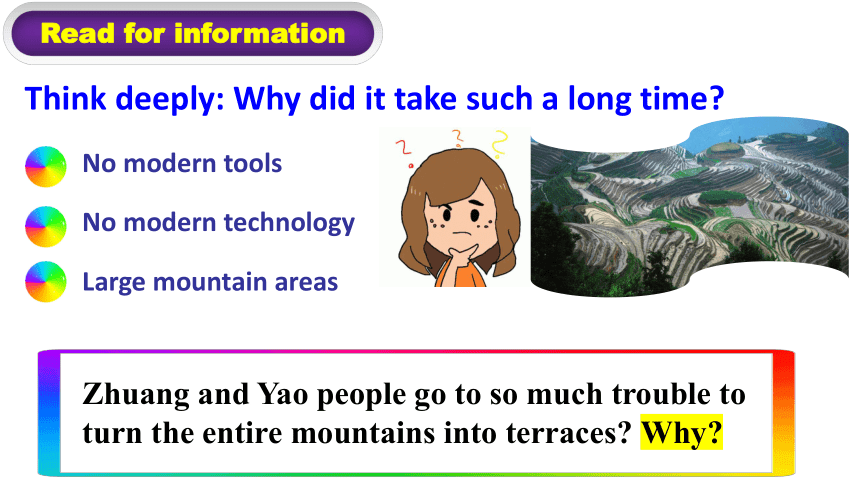
文档简介
(共43张PPT)
Unit 6 At one with nature
Longji Rice Terraces
Understanding ideas
By working with nature,
we humans can make wonders
and live a better life.
What type of text is this passage
A. Narration.
B. Argumentation.
C. Exposition.
D. A travel journal.
Read for structure
Read the passage and match the paragraphs with main ideas.
A the colour of the Longji Rice Terraces
C the history of the Longji Rice Terraces
D the working principle of the terraces
B the reason for building the terraces
E the situation of the terraces now
para.1
para.2
para.3
para.4
para.5
Warming tips:
1. Pay attention to the first sentence and the last sentence in each paragraph.
2. Find the key words and mark them.
Read for structure
Read the passage and match the paragraphs with main ideas.
A the colour of the Longji Rice Terraces
C the history of the Longji Rice Terraces
D the working principle of the terraces
B the reason for building the terraces
E the situation of the terraces now
para.1
para.2
para.3
para.4
para.5
Read for structure
What is the purpose of para. 1
A. To attract potential visitors.
B. To lead to the topic of the passage.
C. To create a particular atmosphere.
D. To share a travel experience.
Read for information
Mountains are wrapped in ___________ , shining in the ______ sun.
_______ sees the mountains turn ____________ with growing rice.
During _______ , these same mountains are ______ .
In ______ they are covered in sheets of __________.
Read paragraph 1 and describe the colour of the terraces in the four seasons.
silver water
spring
Summer
bright green
autumn
gold
winter
white frost
Read for information
1. Who built the Longji Rice Terraces
2. When did people begin to build the terraces
3. When did people complete the building of the terraces
Read paragraph 2 and answer the following questions.
The local Zhuang and Yao people.
In the Yuan Dynasty.
In the early Qing Dynasty.
hundreds of years
Read for information
1. Who built the Longji Rice Terraces
Think deeply: Why did it take such a long time
No modern tools
No modern technology
Large mountain areas
Zhuang and Yao people go to so much trouble to turn the entire mountains into terraces Why
Read for information
Read paragraph 3 and find out why people go to so much trouble to build terraces.
There are few large flat areas of land in the region.
Although the region has plenty of rain, the mountains are steep and the soil is shallow.
natural environment
terraces
people
harmoniously
Firstly
Secondly
effect
results
cause
few large & flat
areas
can't grow
rice
increase the areas to grow rice
steep &
shallow
Soil is washed
away
prevent the soil from
being washed away
make reasonable use of natural resources
How do the terraces work
Para 4. The working principle
The terraces are designed with hundreds of __________. The ____ heats the water and turns it into _______. This forms _______from which _____ falls down onto the mountain terraces once again.
waterways
vapour
sun
clouds
rain
heat
vapor
clouds
rainwater
waterways
How
How clever Chinese people are!
Read paragraph 5 and answer the following question.
Do people still use the ancient way of agriculture to maintain the terraces Why
Yes.
First, this knowledge is passed down through families.
Second, it suits the natural environment.
1) What can we conclude from the last paragraph
A. Modern technology helps people there produce more rice.
B. People still value the ancient growing methods.
C. Many visitors come here to learn how to grow rice.
D. The young people there like to create great wonders.
Read paragraph 5 and complete the following exercises.
Read for information
a food provider
“modern technology helps produce more crops”
a valuable tradition
a tourist attraction
“these terraces still mean a lot to… for whom traditions hold much value… knowledge is passed down… continue to use ancient methods…”
“… attract thousands of visitors”
2) What are the roles/value of terraces at modern times
Read for information
Para. 1
Paras. 2&3
Para. 4
Para. 5
beautiful
scenery
enough
food&
better life
harmonious
ecosystem
valuable tradition & culture
Longji Rice Terraces
a great wonder
harmony between man and nature
Nature
human
At one with nature
Consolidate
The longji rice terraces were enlisted into globally important agricultural heritage in 2018.
Summary
Para. 1
The scenery
Para.2.
The history
Para.3
The reason
Para. 4
The significance
Para. 5
The situation
Longji Rice Terraces
Read for more detailed information
The scenery (Para 1)
mountains _________ in silver water, shining in the spring sun
mountains _________ green with growing rice.
mountains are gold
mountains are covered in _________________
wrapped
turn bright
sheets of white frost
The history (Para 2 )
These terraces ___________ the local Zhuang and Yao people;
Terraces started in the _____________;
These terraces _______________ in the early Qing Dynasty.
were built by
Yuan Dynasty
were completed
The reason (Para 3 )
There are few _______, _____ areas of land in the region.
Building the terraces meant that they could __________.
The steep mountains and shallow soil ______ _______ the rainwater.
large
flat
grow more rice
can’t
catch
The working principle/significance (Para 4)
People have worked in _________ with nature;
The terraces ________________ hundreds of waterways that connect with each other.
harmony
are designed with
Para 5:The present situation
Terraces still to the local people;
hold much value;
New generations continue to use methods.
The Longji Rice Terraces ________ thousands of visitors.
mean a lot
Traditions
ancient
attract
1. What’s the author’s purpose in writing
the passage
A. To praise the wisdom of the ethnic groups living
in Guangxi Zhuang Autonomous Region.
B. To explain how people worked in harmony with
nature to create the Longji Rice Terraces.
C. To describe the beauty of the Longji Rice
Terraces and attract visitors to this scenic spot.
2. Which is not the colour of the Longji Rice Terraces
A. green B. gold C. white D. red
3. How does the author develop Paragraph 1
A. By listing the facts.
B. By comparing the facts.
C. By vividly describing the scene.
D. By painting the beautiful colours.
4. These terraces were built by ________.
A. Han people
B. local Zhuang and Yao people
C. Dai people
D. Tujia people
5. When did people start to build the Longji Rice Terraces
A. In the Yuan Dynasty.
B. In the Qing Dynasty.
C. In the Song Dynasty.
D. In the Tang Dynasty.
6. Which of the following is NOT the reason for
their turning entire mountains into terraces
A. To increase the areas in which they could grow rice.
B. To prevent the soil from being washed away.
C. To catch the rainwater.
D. To attract more visitors.
7. What is it that makes people think the terraces are cleverly designed
A. Flat terraces.
B. Waterways.
C. Rice on terraces.
D. Plants on terraces.
8. What's the most critical feature of the Longji
Rice Terraces
A. It provides more land to grow rice.
B. It can prevent soil from being washed away.
C. It can make a harmonious relationship between
people and nature
D. It keeps the traditional style of ancient terraces.
Summary
The Longji Rice Terraces, which take on different 1._______ in different seasons, were built by the local Zhuang and Yao people. Since there are few large, 2.____ areas that can 3._____ the rainwater and prevent the soil from 4.________________, they built terraces on the mountains to 5.__________ areas to grow rice. The terraces are cleverly designed, with hundreds of waterways 6._________with each other, along which rainwater moves down the mountains and into the terraces. Today, local people use 7._______ methods of agriculture to maintain the terraces. And thousands of visitors come to admire this great 8.______ created by 9.______ and 10. _____ working together.
colours
flat
increase
ancient
catch
being washed away
people
connecting
nature
wonder
We should adapt to local condition(因地制宜)and make use of nature in an environment-friendly way.
Think & Share
In order to live in harmony with nature, what should we do
Imagine mountains wrapped in silver water, shining in the spring sun. Summer sees the mountains turn bright green with growing rice. During autumn, these same mountains are gold, and in winter they are covered in sheets of white frost. These are the colours of the Longji Rice Terraces.
These terraces were built by the local Zhuang and Yao people, to whom Guangxi is home. Starting in the Yuan Dynasty, work on the terraces took hundreds of years, until its completion in the early Qing Dynasty. Reaching as far as the eye can see, these terraces cover tall mountains, often from the bottom to the very top.
So why did these people go to so much trouble to turn the entire mountains into terraces Firstly, there are few large, flat areas of land in the region. Building the terraces therefore meant that they could increase the areas in which they could grow rice. Secondly, although the region has plenty of rain, the mountains are steep and the soil is shallow. The flat terraces catch the rainwater and prevent the soil from being washed away.
But perhaps what is most significant is the way in which people have worked in harmony with nature to make these terraces and grow rice. The terraces are cleverly designed, with hundreds of waterways that connect with each other. During the rainy season, it is along these waterways that rainwater moves down the mountains and into the terraces. The sun heats the water and turns it into vapour.This forms clouds from which rain falls down onto the mountain terraces once again. These terraces also provide a perfect environment for birds and fish, some of which feed on insects that can harm the rice crops.
Although modern technology could help produce more crops, these terraces still mean a lot to the people for whom traditions hold much value. This knowledge is passed down through families, which means that new generations continue to use ancient methods of agriculture to maintain the terraces. Today, the Longji Rice Terraces attract thousands of visitors who come to admire this great wonder created by people and nature working together.
Unit 6 At one with nature
Longji Rice Terraces
Understanding ideas
By working with nature,
we humans can make wonders
and live a better life.
What type of text is this passage
A. Narration.
B. Argumentation.
C. Exposition.
D. A travel journal.
Read for structure
Read the passage and match the paragraphs with main ideas.
A the colour of the Longji Rice Terraces
C the history of the Longji Rice Terraces
D the working principle of the terraces
B the reason for building the terraces
E the situation of the terraces now
para.1
para.2
para.3
para.4
para.5
Warming tips:
1. Pay attention to the first sentence and the last sentence in each paragraph.
2. Find the key words and mark them.
Read for structure
Read the passage and match the paragraphs with main ideas.
A the colour of the Longji Rice Terraces
C the history of the Longji Rice Terraces
D the working principle of the terraces
B the reason for building the terraces
E the situation of the terraces now
para.1
para.2
para.3
para.4
para.5
Read for structure
What is the purpose of para. 1
A. To attract potential visitors.
B. To lead to the topic of the passage.
C. To create a particular atmosphere.
D. To share a travel experience.
Read for information
Mountains are wrapped in ___________ , shining in the ______ sun.
_______ sees the mountains turn ____________ with growing rice.
During _______ , these same mountains are ______ .
In ______ they are covered in sheets of __________.
Read paragraph 1 and describe the colour of the terraces in the four seasons.
silver water
spring
Summer
bright green
autumn
gold
winter
white frost
Read for information
1. Who built the Longji Rice Terraces
2. When did people begin to build the terraces
3. When did people complete the building of the terraces
Read paragraph 2 and answer the following questions.
The local Zhuang and Yao people.
In the Yuan Dynasty.
In the early Qing Dynasty.
hundreds of years
Read for information
1. Who built the Longji Rice Terraces
Think deeply: Why did it take such a long time
No modern tools
No modern technology
Large mountain areas
Zhuang and Yao people go to so much trouble to turn the entire mountains into terraces Why
Read for information
Read paragraph 3 and find out why people go to so much trouble to build terraces.
There are few large flat areas of land in the region.
Although the region has plenty of rain, the mountains are steep and the soil is shallow.
natural environment
terraces
people
harmoniously
Firstly
Secondly
effect
results
cause
few large & flat
areas
can't grow
rice
increase the areas to grow rice
steep &
shallow
Soil is washed
away
prevent the soil from
being washed away
make reasonable use of natural resources
How do the terraces work
Para 4. The working principle
The terraces are designed with hundreds of __________. The ____ heats the water and turns it into _______. This forms _______from which _____ falls down onto the mountain terraces once again.
waterways
vapour
sun
clouds
rain
heat
vapor
clouds
rainwater
waterways
How
How clever Chinese people are!
Read paragraph 5 and answer the following question.
Do people still use the ancient way of agriculture to maintain the terraces Why
Yes.
First, this knowledge is passed down through families.
Second, it suits the natural environment.
1) What can we conclude from the last paragraph
A. Modern technology helps people there produce more rice.
B. People still value the ancient growing methods.
C. Many visitors come here to learn how to grow rice.
D. The young people there like to create great wonders.
Read paragraph 5 and complete the following exercises.
Read for information
a food provider
“modern technology helps produce more crops”
a valuable tradition
a tourist attraction
“these terraces still mean a lot to… for whom traditions hold much value… knowledge is passed down… continue to use ancient methods…”
“… attract thousands of visitors”
2) What are the roles/value of terraces at modern times
Read for information
Para. 1
Paras. 2&3
Para. 4
Para. 5
beautiful
scenery
enough
food&
better life
harmonious
ecosystem
valuable tradition & culture
Longji Rice Terraces
a great wonder
harmony between man and nature
Nature
human
At one with nature
Consolidate
The longji rice terraces were enlisted into globally important agricultural heritage in 2018.
Summary
Para. 1
The scenery
Para.2.
The history
Para.3
The reason
Para. 4
The significance
Para. 5
The situation
Longji Rice Terraces
Read for more detailed information
The scenery (Para 1)
mountains _________ in silver water, shining in the spring sun
mountains _________ green with growing rice.
mountains are gold
mountains are covered in _________________
wrapped
turn bright
sheets of white frost
The history (Para 2 )
These terraces ___________ the local Zhuang and Yao people;
Terraces started in the _____________;
These terraces _______________ in the early Qing Dynasty.
were built by
Yuan Dynasty
were completed
The reason (Para 3 )
There are few _______, _____ areas of land in the region.
Building the terraces meant that they could __________.
The steep mountains and shallow soil ______ _______ the rainwater.
large
flat
grow more rice
can’t
catch
The working principle/significance (Para 4)
People have worked in _________ with nature;
The terraces ________________ hundreds of waterways that connect with each other.
harmony
are designed with
Para 5:The present situation
Terraces still to the local people;
hold much value;
New generations continue to use methods.
The Longji Rice Terraces ________ thousands of visitors.
mean a lot
Traditions
ancient
attract
1. What’s the author’s purpose in writing
the passage
A. To praise the wisdom of the ethnic groups living
in Guangxi Zhuang Autonomous Region.
B. To explain how people worked in harmony with
nature to create the Longji Rice Terraces.
C. To describe the beauty of the Longji Rice
Terraces and attract visitors to this scenic spot.
2. Which is not the colour of the Longji Rice Terraces
A. green B. gold C. white D. red
3. How does the author develop Paragraph 1
A. By listing the facts.
B. By comparing the facts.
C. By vividly describing the scene.
D. By painting the beautiful colours.
4. These terraces were built by ________.
A. Han people
B. local Zhuang and Yao people
C. Dai people
D. Tujia people
5. When did people start to build the Longji Rice Terraces
A. In the Yuan Dynasty.
B. In the Qing Dynasty.
C. In the Song Dynasty.
D. In the Tang Dynasty.
6. Which of the following is NOT the reason for
their turning entire mountains into terraces
A. To increase the areas in which they could grow rice.
B. To prevent the soil from being washed away.
C. To catch the rainwater.
D. To attract more visitors.
7. What is it that makes people think the terraces are cleverly designed
A. Flat terraces.
B. Waterways.
C. Rice on terraces.
D. Plants on terraces.
8. What's the most critical feature of the Longji
Rice Terraces
A. It provides more land to grow rice.
B. It can prevent soil from being washed away.
C. It can make a harmonious relationship between
people and nature
D. It keeps the traditional style of ancient terraces.
Summary
The Longji Rice Terraces, which take on different 1._______ in different seasons, were built by the local Zhuang and Yao people. Since there are few large, 2.____ areas that can 3._____ the rainwater and prevent the soil from 4.________________, they built terraces on the mountains to 5.__________ areas to grow rice. The terraces are cleverly designed, with hundreds of waterways 6._________with each other, along which rainwater moves down the mountains and into the terraces. Today, local people use 7._______ methods of agriculture to maintain the terraces. And thousands of visitors come to admire this great 8.______ created by 9.______ and 10. _____ working together.
colours
flat
increase
ancient
catch
being washed away
people
connecting
nature
wonder
We should adapt to local condition(因地制宜)and make use of nature in an environment-friendly way.
Think & Share
In order to live in harmony with nature, what should we do
Imagine mountains wrapped in silver water, shining in the spring sun. Summer sees the mountains turn bright green with growing rice. During autumn, these same mountains are gold, and in winter they are covered in sheets of white frost. These are the colours of the Longji Rice Terraces.
These terraces were built by the local Zhuang and Yao people, to whom Guangxi is home. Starting in the Yuan Dynasty, work on the terraces took hundreds of years, until its completion in the early Qing Dynasty. Reaching as far as the eye can see, these terraces cover tall mountains, often from the bottom to the very top.
So why did these people go to so much trouble to turn the entire mountains into terraces Firstly, there are few large, flat areas of land in the region. Building the terraces therefore meant that they could increase the areas in which they could grow rice. Secondly, although the region has plenty of rain, the mountains are steep and the soil is shallow. The flat terraces catch the rainwater and prevent the soil from being washed away.
But perhaps what is most significant is the way in which people have worked in harmony with nature to make these terraces and grow rice. The terraces are cleverly designed, with hundreds of waterways that connect with each other. During the rainy season, it is along these waterways that rainwater moves down the mountains and into the terraces. The sun heats the water and turns it into vapour.This forms clouds from which rain falls down onto the mountain terraces once again. These terraces also provide a perfect environment for birds and fish, some of which feed on insects that can harm the rice crops.
Although modern technology could help produce more crops, these terraces still mean a lot to the people for whom traditions hold much value. This knowledge is passed down through families, which means that new generations continue to use ancient methods of agriculture to maintain the terraces. Today, the Longji Rice Terraces attract thousands of visitors who come to admire this great wonder created by people and nature working together.
